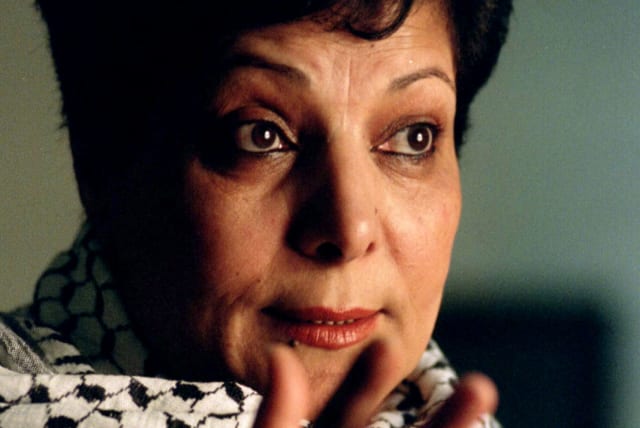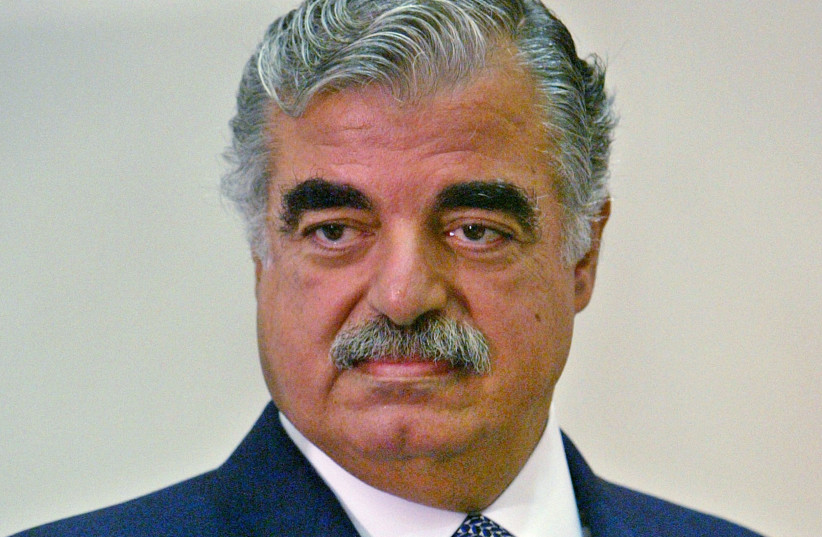Palestinian terrorist Leila Khaled says ex-Lebanon PM sent PFLP weapons to Europe

Palestinian terrorist Leila Khaled described former Lebanese Prime Minister Rafik Al-Hariri's alleged role in Palestinian terrorism in Europe.
Convicted Palestinian terrorist Leila Khaled - who carried out the hijacking of a Trans World Airlines flight to Tel-Aviv in 1969 and sought to hijack an El-Al flight to New York in 1970 - claimed in an interview this month that former Lebanese Prime Minister Rafik Al-Hariri was active in the terrorist group the Popular Front for the Liberation of Palestine (PFLP) and that he helped transfer PFLP weapons to Europe in 1970 and 1971.
Khaled, 78, a member of the Palestinian National Council, told the London-based daily Al-Sharq Al-Awsat on February 12 and 13 about Al-Hariri's alleged role in Palestinian terrorism in Europe. The Middle East Media Research Institute (MEMRI) posted parts of the interview on its website.
Khaled said that Al-Hariri - who was assassinated by the Lebanese terrorist movement Hezbollah in 2005 - transferred weapons "To Europe, and he did that more than once between 1970 and 1971. At that time, he was working in Saudi Arabia."
Khaled said she was "not sure" if Hariri financed the PFLP. "All I witnessed was his assignment to transfer weapons. The rule of thumb was that no one should know anything except for what they have to complete their mission."
The US and Europe designated the PFLP a foreign terrorist organization.
When asked about the reason for assigning Al-Hariri a job to transfer weapons while he worked in the Kingdom Saudi Arabia, Khaled said "I told you what I know. Perhaps because his passport did not arouse suspicion."
"Khaled refused to talk about how Hariri got the weapons to pass through the airports of France, Spain, and Germany," Al-Sharq Al-Awsat wrote.
According to Al-Sharq Al-Awsat, "Hariri got acquainted with the names of George Habash and Haddad and got to know them later. His role was modest. He participated in a committee headed by Haddad, which was concerned with providing facilities to some members of the movement, such as finding homes for rent and services of this kind. Hariri was also tasked with delivering the movement’s publications secretly to its members in Syria. He chose to hide these leaflets in the vegetable trucks that were traveling from Sidon to the Syrian cities. Those days were the thread that linked Hariri to some of the movement's symbols before the birth of the 'Popular Front for the Liberation of Palestine' led by Habash."
George Habash (1926-2008) was the founder of the PFLP. Wadie Haddad (1927-1978), also known as Abu Hani, was a leader of the PFLP who was tasked with airplane hijackings, including the seizure of the Entebbe plane.
Mossad's alleged assassination attempt on Haddad
In response to a question about the Mossad's alleged assassination attempt on Haddad, Khaled, who was with Haddas at the time of the attack, said "Haddad was adhering to strict security measures and all his movements were surrounded by complete secrecy. However, they succeeded in hitting his apartment in Al-Zarif in Beirut with six missiles directed at the bedrooms at 2:00 am. Fortunately, I was sitting with him in the dining room. I had to travel in the morning, but I was supposed to write down the details of the operation that was supposed to lead me to Tel Aviv. I was writing the details to send to the leadership when the explosions went off."
Khaled added that "I was thrust from my place, and we heard the screams of Hani, Haddad’s son. Haddad was not injured, but shrapnel hit his son in more than one place. The glass in the apartment shattered and we felt as if we were suffocating. The closet was on fire and was about to fall on Hani, who was lying in his bed. Haddad came forward and I saw his hands were burning, but he was able to carry Hani and give him to me. The boy was bleeding, so I picked him up. But I didn't know how to open the door. Haddad came with his burning hands and grabbed the lock. The missiles hit, especially the lower and upper floors, and I still remember Haddad’s sentence in those harsh conditions when he said: Their operation failed."
Khaled said her terrorism operation was canceled to secure a fake passport to Tel Aviv and spend her honeymoon there, and then carry out the operation. "In the hospital, we had to think of a response, and I brought a book about the flights of Israeli planes to and from Tel Aviv. I spotted three planes that can be hunted almost simultaneously. I presented the idea to Haddad and he liked it."
Khaled confirmed that the KGB provided the PFLP with weapons and equipment. Haddad conducted a series of meetings with Soviet officials that addressed military, political and technical issues. The talks ended with a meeting with KGB leader Yuri Andropov, who wrote the paper based on the interview with Khaled. Haddad rejected the two-state solution, saying "our country is one and indivisible. We have never thought about the rise of two states. If the whole of Palestine, including Jerusalem, but excluding Haifa, were to be offered to us, we would turn it down."
When asked if the Mossad had cornered her, Khaled told the paper "Yes, in Beirut. They planted an explosive under my bed. Security measures at the time demanded that we change our apartments constantly. I was training women in the South and the Bekaa. I would return exhausted to my temporary furnished apartment in the capital. I would immediately collapse in bed and get as much rest as possible."
Khaled claims that she entered her apartment in Beirut’s Caracas neighborhood and noticed a black box under her bed. "I wasn’t sure if that box was mine. I had my doubts. I immediately went to the PFLP office. A explosives expert head to the apartment and discovered that the box held ten kilograms of explosives," Khaled said.
Jerusalem Post Store
`; document.getElementById("linkPremium").innerHTML = cont; var divWithLink = document.getElementById("premium-link"); if (divWithLink !== null && divWithLink !== 'undefined') { divWithLink.style.border = "solid 1px #cb0f3e"; divWithLink.style.textAlign = "center"; divWithLink.style.marginBottom = "15px"; divWithLink.style.marginTop = "15px"; divWithLink.style.width = "100%"; divWithLink.style.backgroundColor = "#122952"; divWithLink.style.color = "#ffffff"; divWithLink.style.lineHeight = "1.5"; } } (function (v, i) { });

